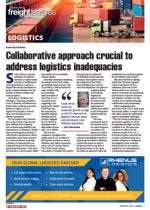As global supply chains grow more intricate, robust Transportation Management Systems (TMS) are critical for facilitating streamlined operations and precise oversight. Whilst TMS is a widely used term in the logistics sector, its interpretation can vary significantly based on factors such as a company's scale, operational intricacies, sub-industry classification, and even its geographic presence. Renko Bergh, COO of the Forte Group, makes a case for a TMS
Gartner defines a TMS as software designed to facilitate the multimodal planning and execution of physical goods movement throughout the supply chain. But what does a typical TMS offer in its broadest definition? A TMS is a software system that helps companies manage logistics associated with the movement of physical goods – by land, air, sea, or a combination of transportation modes. A TMS is the backbone of logistics operations. The software captures data from the moment a shipment order is created. It helps to plan, execute and optimise the shipping of goods. A TMS offers a diverse range of functions, including optimising terrestrial transport orders, selecting transportation modes and providers for inbound and outbound shipments, overseeing various transport modes like motor carrier, rail, air, and maritime, real-time tracking of transportation, monitoring service quality through KPIs, optimising vehicle loads and routes, simulating transport costs and schemes, batching orders for efficient shipment, conducting freight negotiations, and providing comprehensive cost control along with reporting and statistical insights through KPIs.However, the main value drivers from each TMS, regardless of definition or interpretation, are to plan, optimise and execute orders. When looking at each main value driver on its own, it is important to note that many TMS developers and offerings in the market have created market share by simply focusing on certain features based on these value drivers. Under the planning umbrella, essential components are encompassed within a central TMS or specialised applications dedicated to this aspect. These include order management, load planning, shipment rate management, and order tendering. Notably, platform-based applications streamlining order tendering and acceptance have emerged as game-changers within the industry, a trend reverberating in the South African market due to mounting interest.The focus within the execution feature is on f leet management, document management, delivery management of orders with track and traceability. It also predominantly looks at the last-mile segment of the market. The optimised value driver of a TMS is typically the widely known and adopted feature including route planning and routing, vehicle capacity to load demand matching, cost management and operational intelligence. The use of specific TMS platformsShipper-focused TMS platforms cater to cargo owners, essentially the retailers within the value chain. These shippers utilise TMS applications to gain comprehensive visibility into their networks, streamline manual order tendering and management processes, and notably, curtail transportation expenditures across various utilised transporters within the network.Carrier-oriented TMS solutions are tailored to cargo transporters and are categorised into secondary transport and linehaul transport operators. For carrier operators, a TMS primarily serves the purpose of planning and executing orders seamlessly. Secondary transporters, utilising diverse vehicle capacity types, grapple with numerous variables, necessitating a robust planning tool adept at integrating multiple inputs to optimise delivery and collection plans. On the other hand, primary transporters, dealing with comparatively fewer planning variables, channel their focus into f leet management aspects encompassing fuel, maintenance, and driver oversight, including driving hours.Last-mile solutions Last-mile TMS solutions primarily centre around the delivery phase of orders, with a strong emphasis on ensuring accurate proof of deliveries. These solutions are instrumental in driving the adoption of electronic proof of deliveries through driver-centric applications that facilitate "sign on glass" capabilities.Irrespective of how the core features of a TMS are perceived or the distinct subsectors of the supply chain that integrate TMS solutions, these applications assume a central role in the realm of supply chains. At its core, supply chain management encompasses the planning, control, and execution of product f low throughout its lifecycle – from raw materials to production and distribution. Transportation serves as an integral component across all major stages of this process.Raw materials, for example, need transporting from their original location – perhaps a mine or a farm – to the supplier's processing plant. While the materials' ultimate destination is likely to be a manufacturer, there may be intermediate locations along the way. The manufacturing process itself might require additional shipments if, for example, subassemblies need to be moved between the manufacturer's facilities or to those of a subcontractor.Distribution of final productDistribution of the final product typically requires several steps that may involve more than one mode of transportation – say, when products made in China are shipped overseas, received in a port and placed on trucks. Even the final shipment to the retail store or the customer's home isn't the end of it. In reverse logistics, the product is returned to the distributor or manufacturer for servicing or refurbishment only to be shipped back to the customer or store for resale, or the product might be transported to a recycling facility or landfill.The future of transport management solutions within the South African market is at an all-time high in terms of adaption and derived value gained with the implementation thereof. Traditionally secondary transport operators have been spoiled with locally created TMS solutions focusing on planning and execution. In the last two to five years shippers in South Africa have adopted an in-house approach to transport management and with fewer locally based solutions within this space, have imported many of the top-tier Gartner shipper-based TMS applications in the market

